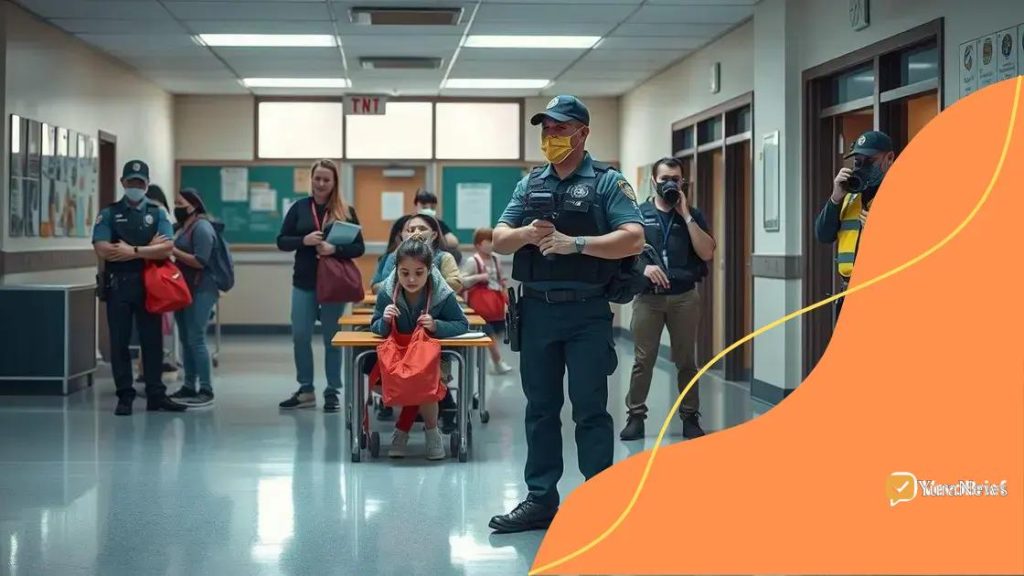School safety debates intensify: What you need to know

Anúncios
School safety debates intensify after recent incidents, focusing on collaboration between parents, technology integration, and mental health support to create secure learning environments.
School safety debates intensify after recent incidents, raising crucial discussions about how to best protect students in today’s environment. What can be done to ensure safety and peace of mind? Let’s explore.
Anúncios
Recent incidents that sparked debate
In recent months, a series of alarming events has fueled discussions around school safety. These incidents have raised critical questions about how to protect students while fostering a positive learning environment. Understanding these events is essential for all involved in education.
High-profile incidents
A number of high-profile incidents, including school shootings and violence, have occurred, shaking communities to their core. Each event not only affects those directly involved but also resonates deeply within the wider community, prompting calls for action and comprehensive changes. Our schools should feel safe, and when they don’t, it creates fear and resistance against education.
Community reactions
Responses to these incidents can vary widely, reflecting differing opinions on how to improve safety. Some community members advocate for increased security measures, including:
Anúncios
- Enhanced surveillance systems
- Strict access controls
- Regular safety drills
- Increased presence of law enforcement
While others emphasize the need for mental health resources and conflict resolution programs. These diverse opinions highlight the challenges we face when finding effective solutions that cater to the needs of all students.
The impact of these incidents fuels a nationwide dialogue on the importance of preventive measures. Schools are not just places for education; they should also be safe havens for children. Through understanding recent events, we can focus on proactive solutions that address parental concerns, student safety, and educational integrity.
Different perspectives on school safety
In the ongoing conversation about school safety, various perspectives emerge, highlighting the complex nature of the issue. Different stakeholders, including parents, students, teachers, and law enforcement, each have unique views shaped by their experiences and concerns.
The role of parents
Parents often prioritize their children’s safety above all else. They tend to advocate for stronger security measures such as:
- Enhanced security systems
- Regular safety drills
- Increased communication about safety protocols
These actions reflect the deep-seated need for reassurance in an environment that parents believe should be inherently safe. Listening to these concerns is crucial in creating effective safety policies.
Student voices
Students have their own ideas about what constitutes a safe school. Many emphasize the importance of a supportive atmosphere where they can express themselves without fear. They often suggest that safety measures should not only focus on physical security but also on mental health support, highlighting the need for:
- Access to counseling services
- Bullying prevention programs
- Open forums for students to discuss their concerns
When students feel heard and valued, they are more likely to contribute positively to their school environment.
Teachers share insights shaped by their daily interactions with students. They often advocate for a balanced approach that combines security with emotional well-being. By fostering a sense of community, teachers believe that they can effectively combat fear and anxiety among students. Programs that promote social skills and conflict resolution become integral in this framework, demonstrating a commitment to proactive safety measures.
Effective safety measures and strategies

Implementing effective safety measures in schools is essential for creating an environment where students can learn without fear. Various strategies have been developed to address safety concerns, focusing on both prevention and response.
Physical security enhancements
One of the most visible aspects of school safety is physical security. Many schools have upgraded their facilities with robust measures, including:
- Installation of security cameras
- Controlled access points
- Effective lighting in and around school grounds
These upgrades help deter potential threats and ensure a safer environment. These measures also provide peace of mind to parents and staff, knowing that the school is taking necessary precautions.
Emergency preparedness
Schools are also focusing on emergency preparedness. Regular drills are conducted to ensure that staff and students know what to do in various emergency situations. Some key components include:
- Fire drills and lockdown drills
- Clear communication plans for emergencies
- Involving local law enforcement in training
These practices can save lives during critical moments by increasing awareness and readiness among students and staff.
Moreover, addressing the emotional well-being of students is crucial. Schools can implement programs that focus on conflict resolution and peer support. By teaching students how to manage conflicts peacefully, schools can reduce the likelihood of violent incidents. Initiatives that build a sense of community can contribute to a positive school culture.
The role of parents and communities
The involvement of parents and communities is crucial in enhancing school safety. When families and local organizations take an active role, it helps create a supportive environment for students. Parents need to be aware of safety protocols and contribute to discussions about effective measures.
Collaboration with schools
Collaboration between parents and schools can lead to more comprehensive safety plans. By working together, they can identify potential risks and create strategies to address them. Some important aspects of this collaboration include:
- Open communication about safety issues
- Participation in safety meetings and events
- Support for programs that promote a positive school culture
Parent-teacher associations can serve as platforms for these discussions, ensuring that everyone’s voice is heard and valued.
Community support
The community also plays a vital role in promoting school safety. Local organizations can provide valuable resources and support systems. Programs that engage students, like mentoring and after-school activities, can strengthen connections between schools and the community. When students feel supported by their community, it enhances their overall well-being and sense of belonging. Moreover, neighborhood watch programs can assist in maintaining the safety of the area surrounding the school.
Parents can also advocate for policies that prioritize school safety at local government meetings. When communities unite to support schools, it becomes easier to push for necessary changes. Effective safety strategies often come from a united effort where everyone understands the importance of a safe learning environment.
Looking ahead: Future of school safety
The future of school safety looks to be shaped by ongoing innovations and community involvement. As new technologies emerge, schools are adopting strategies that promote safety while also fostering a positive atmosphere for learning.
Integration of technology
One significant trend is the integration of technology in safety measures. Schools are beginning to use advanced tools like:
- Real-time surveillance systems
- Automated emergency alerts
- Mobile apps for communication in crises
These innovations can provide faster responses during emergencies and keep parents informed, increasing overall safety and peace of mind.
Focus on mental health
Another important aspect of future safety strategies is the emphasis on mental health. Schools are starting to recognize that emotional well-being impacts safety. By offering mental health resources, schools can:
- Implement counseling programs
- Encourage peer support initiatives
- Reduce stigma around mental health issues
This shift towards understanding and addressing mental health is crucial for preventing incidents and creating supportive environments.
Moreover, engaging students in discussions about safety can help to empower them. Schools that actively involve students in creating safety plans are likely to see increased awareness and responsibility among them. By educating students about safety, they become active participants rather than passive observers.
FAQ – Questions About School Safety
What is the role of parents in school safety?
Parents play a crucial role by collaborating with schools and advocating for effective safety measures.
How can technology enhance school safety?
Technology can improve safety through advanced surveillance systems, emergency alert mechanisms, and communication tools.
Why is mental health important for school safety?
Focusing on mental health helps prevent incidents and promotes a supportive environment for all students.
How can students get involved in safety discussions?
Students can participate in safety committees and programs, allowing their voices to be heard in creating safety plans.